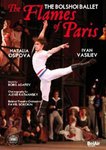|
Back
03/13/2016
Boris Asafiev: The Flames of Paris (Les Flammes de Paris)
(Choreography by Alexei Ratmansky after Vasily Vaynonen)
Natalia Osipova (Jeanne), Ivan Vasiliev (Philippe), Denis Savin (Jérôme), Yuri Klevisov (The Marquis Costa de Beauregard), Nina Kaptsova (Adeline), Anna Antonicheva (Mireille de Poitiers), Ruslan Skvortsov (Antoine Mistral), Yuliana Malkhasyants (Jarcasse), Vitaly Biktimirov (Gilbert), Gennadi Yanin (King Louis XVI), Olga Suvorova (Marie Antoinette), Yevgenia Volochkova (Lucille), Yekaterina Krysanova (Amour), Victoria Osipova (Phantom), Andrei Sitnikov (President of The Convention), Alexei Loparevich (Master of Ceremonies), Yegor Simachev (David), Anastasia Vinokur (Singer), The Bolshoi Ballet, Bolshoi Theatre Orchestra, Pavel Sorokin (Conductor), Ilya Utkin/Evgeny Monakhov (Scenic Designers), Yelena Markovskaya (Costume Designer), Damir Ismagilov (Lighting Designer), Vincent Bataillon (TV and Video Director)
A co-production of Bel Air Media,Telmondis, NHK, Bolshoi Theatre, Moscow
High definition recording: Bolshoi Theatre, Moscow (March 2010) – 124’ (including bonus)
BelAir Classiques #BAC062 or Blu-ray #BAC462 – Sound 2.0 PCM – Format 5:1 Dolby Digital – Color, 16:9 – Region 0 – Subtitles in English, French and German – Booklet in English, French and German (Distributed by Naxos of America)

   
Nowadays we see it everywhere in the arts: taking an established masterpiece and parsing it to current relevancy or quasi-contemporary nature. Such an invigorating and meaningful case can be made via Vasily Vaynonen’s 1932 original choreography ensconced by Boris Asafiev’s vivacious dialogue. Asafiev, born a mere 33 years before the 1917 Romanov Dynasty overthrow, uses personal experiences to paint the ballet with a loose foundation of songs reflected from The French Revolution. Ironically, Asafiev’s musical sympathies strike against a Bolshevik forward momentum.
The Kirov’s (where the ballet originally premiered followed a year later by The Bolshoi) packed house of Soviet enthusiasts (including Stalin himself) was unquestionably gelled by Vaynonen’s frenetic whirling dance ensembles, emulating the country’s own fight for personal freedoms. Back then the heroic character centered around the corps de ballet though it rendered only superficially “feel good” sensations and absences of love connects or human tension. This is where Ratmansky makes his broad, intelligent divergent reconstruction to better represent The Bolshoi of the 21st century. Thus, we have a firm grounding of Vaynonen congealed with imaginative artistry by the Ukrainian native.
Les Flammes could be argued as a poignant dance version of Giordano’s Andrea Chénier or even a distant second to Respighi’s Marie Victoire (Read here). There is a commingling between Marseille’s sans-culotte populace and the Ancien Régime with entangled love affairs.
Despite a credited Soviet musicologist, Asafiev relied heavily on a mélange of styles glancing back to Baroque and Classical periods with pockets of folk dancing throughout. His foreboding “Overture” is a window on Beethoven, but glances at Rossini while the subsequent “Marseillais battalion” brings out Auber’s Gallic patriotic delineations.
Just as vivacious as seen in her later interpretation of Hérold’s La Fille mal gardée in 2015 (Read here),
Natalia Osipova’s enthralling artistry leaves nothing to the imagination, drawing firm imprints upon The Vaganova discipline. Similarly, Ivan Vasiliev’s muscular, hunky physique epitomizes those predetermined elements of athleticism and Italianate technique. Both follow Ratmansky’s incisive footwork, following each of Asafiev’s notes in the most literal sense. The two protagonists’ Pas de deux will leave one’s mouth agape. Pavel Sorokin reinforces these punctuated moves by taking Asafiev’s economical score and templating it to an exceptionally fine tempo.
Les Flammes has its fair share of pantomime value that could almost be described as a coarse bordering of Bournonville manière. Such an example is Adeline’s evil minder, Jarcasse (Yuliana Malkhasyants), a reminiscence of Old Madge from La Sylphide, alongside the Marquis Costa de Beauregard’s (Yuri Klevtsov) advances for Jeanne. If the Jeanne/Philippe attraction develops more simply, there’s a more evened, softened approach between Adeline (Nina Kaptsova) and Jeanne’s brother, Jérôme (Denis Savin.) The pair’s emotions, inside the “Love” Pas de deux highlighting Kaptsova’s floating and weightless pliancy, is spellbinding.
One of Boris Asafiev’s other beauties is to showcase two more prominent dancers in the quasi Greco-classical manner during the Rinaldo et Armida ballet: Anna Antonicheva and Ruslan Skvortsov shine brilliantly in the roles of Mireille de Poitiers and Antoine Mistral, respectively. Antonicheva demonstrates a delightfully though painstakingly difficult pirouette en dehors en pointe in slow motion.
Because we’re witnessing social upheaval in France, a predominant characteristic of folk dancing pervades. The Bolshoi’s corps de ballet rates a 100% when it comes to the synchronization and clean lines found in the ebullient Provençe “Farandole”, the derivative “Carmagnole”, the oenophilic “Auvergne Dance” and lastly, and most importantly, the spiky revolutionary “Dance of the Basques.” The Royal Palace, housing France’s one percent, renders a lilting “Minuet” especially charmed by their richly brocaded clothing by Yelena Markovskaya.
Inside Les Flammes de Paris’ closing musical arguments we hear the emblematic “Cą ira” with its advancing crowd and waving French Republic flag that can’t help but harken back to Claude-Michel Schönberg’s Les Misérables.
Even though Ilya Utkin’s and Evgeny Monakhov’s scenic backdrops are of a two dimensional nature using a detailed ink hatching technique to create specific locales (i.e. the Tuileries), the effect yields extraordinary depth. Lighting by Damir Ismagilov enables ballet sets to innocuously melt like ice only to be gracefully unpeeled into another discovery.
The Bolshoi Theatre Orchestra brings sophistication and limpid expression to Boris Asafiev’s score. By far, the music is more broadly aligned with Western Europe and late French romanticism with a Russian edging.
BelAir Classiques video edits are some of the finest ever seen. Camera fades are never obtrusive and never disrupt the adventure. The Bolshoi Theatre Orchestra is flawless. Any ballet enthusiast will want to have this for his/her collection: lively, passionate, and energetic. This is one of the most impressive experiences of a lifetime.
Christie Grimstad
|